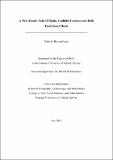A new model: Seán Ó Riada, Ceoltóirí Cualann and Irish traditional music
Date
2020-07-19Author
Egan, Malachy Bernard
Metadata
Show full item recordUsage
This item's downloads: 1453 (view details)
Abstract
This interdisciplinary thesis examines the history of Seán Ó Riada’s traditional ensemble Ceoltóirí Cualann and investigates the significance of the new group model for Irish traditional music that Ó Riada developed from 1960-1970. In particular, this study identifies Ceoltóirí Cualann as a demonstration of Ó Riada’s methodological approach to Irish traditional music. The history of ensemble performance within traditional music in Ireland is encapsulated by the various groups that emerge over the course of the twentieth century, particularly the varied models that develop from the 1960s onward. It is also a period in which the first generation to be born post-independence are redefining their cultural identity within the Irish Free State. Ó Riada’s position within such a generation, and the modes of expression he utilises as part of that process, is a central feature of this study. As part of this thesis, an interdisciplinary theoretical model is employed in which the opening two chapters outline a concise history and chronology of events; which is then followed by an evaluation of both the music and methodology adopted by Ó Riada in the remaining chapters. By identifying the formation of Ceoltóirí Cualann as a significant moment, this thesis explores the manner in which the group was formed, the direction they undertook, and the wider place of Ceoltóirí Cualann within Irish cultural life. This theoretical framework expands the epistemological field of Irish Studies, as well as drawing from the disciplines of cultural history, music studies and social geography. By adopting such a structure, it paves the way for further research in related fields.


